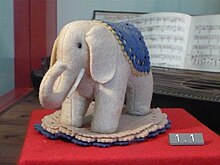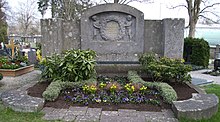Margarete Steiff
Apollonia Margarete Steiff (* July 24, 1847 in Giengen an der Brenz ; † May 9, 1909 there ) was the founder of the Steiff GmbH toy factory of the same name .
Life
youth
Margarete Steiff was born as the third of four children of the married couple Friedrich and Maria Margarete Steiff (née Hähnle, ad. Wulz) in Giengen, Swabia. At the age of 18 months she developed a severe fever and was then partially paralyzed; later she was diagnosed with polio . The illness did not prevent Margarete Steiff from developing into a happy child with above-average grades and great organizational talent. Whenever her time allowed, Margarete played with the local children. She also looked after the children of mothers who had to work.
She was brought up very strictly by her parents, which is why she lived up to it in the summer of 1856 while she lived with the family of August Hermann Werner , the founder of the Werner Clinic. After an operation on her legs, which brought no improvement, Margarete came to Bad Wildbad for a cure . She found the cure to be a pleasure, even though she was separated from her family for several months due to her stay in Ludwigsburg and Wildbad. Her wish to attend sewing school was enforced against the wishes of her parents. Due to her paralysis, she had difficulties, but soon became a good seamstress .
Company formation
In 1874, her father converted the house on Ledergasse and set up a tailor's shop. Margarete and her sister soon had many jobs and were the first to buy their own sewing machine in town . Although Margarete could only operate it from the wrong side due to her paralysis, she quickly became very productive. In 1877 she opened a felt shop on the advice of her cousin Wilhelm Adolf Glatz by marriage . The shop developed into a small business with several permanent seamstresses.
In 1879 Margarete Steiff discovered the pattern of an elephant in a fashion magazine and together with her seamstresses made two sacks full of pin cushions in this form for the Heidenheimer Markt. The “Elefäntle” were a complete success, so that other animals were designed and produced as well. While Margarete bought felt for the animals in 1886 for 1,460 marks , four years later it was already an item for 5,070 marks. The first illustrated Steiff catalog was published in 1892. In addition to elephants, the range also included numerous other animals such as dogs, cats and horses. Margarete's motto was also in the catalog: “Only the best is good enough for children”. In 1893 sales of toys rose to 16,000 marks above that of felt goods. In 1901, the toy was exported to the USA , with sales of over 180,000 marks.
In 1902 Richard Steiff , a nephew of the company's founder , developed the company's figurehead: the teddy bear 55 PB , as one of the first of its kind (the invention is also attributed to others, see teddy bear ); it was initially produced unsuccessfully. Only at the end of the Leipzig Toy Fair , where it was presented, were 3000 copies sold.
Retirement
After Margarete Steiff GmbH was founded in 1906, the management passed to the nephew Margarete Steiffs. By 1907, the number of sewn teddy bears rose to 973,999. In addition, the 400 employees and 1,800 home workers produced a total of around 1,700,000 toys. On May 9, 1909, Margarete Steiff died at the age of 61 from complications from pneumonia .
Legacy
- In the “World of Steiff” visitors are shown the history of the teddy bear and the company's history.
- The factory halls, popularly known as the " Jungfrau aquarium ", set new accents in the history of architecture.
- In Giengen the local high school was named after Margarete Steiff.
- In Stuttgart there is the Margarete Steiff School special education and advice center .
- The film biography Margarete Steiff (2005) with Heike Makatsch in the title role and directed by Xaver Schwarzenberger describes the life of the entrepreneur until her first business successes.
Honors
One of the first new Intercity Express trains ( ICE 4 ) was named after Margarete Steiff at the end of October 2017 .
literature
- Annegret Erhard: Margarete Steiff. Ullstein, Berlin 1999, ISBN 3-548-35945-0 , (biography and company history).
- Bernd Brunner: A Brief History of the Bears. Claassen, Berlin 2005, ISBN 3-546-00395-0 .
- Ulrike Halbe-Bauer: Margarete Steiff: “I give what I can”. A biographical novel. Brunnen, Giessen 2007, ISBN 978-3-7655-1965-9 .
- Wolfgang Heger: The gateway to childhood. The world of Margarete Steiff , Mitteldeutscher Verlag, Halle (Saale) 2009, ISBN 978-3-89812-634-2 .
- Gabriele Katz: Margarete Steiff. The biography. New, revised edition. The Kleine Buch Verlag, Karlsruhe 2015, ISBN 978-3-7650-8902-2 .
- Sabine Völker-Kramer: How I became a teddy mother. Margarette Steiff's life according to her own records. Quell, Stuttgart 1996, ISBN 3-7918-1978-X .
documentary
- Big ideas - small flops: flashes of inspiration from A to Z. Documentation, Germany, 2016, 89:30 minutes, script and direction: Andreas Kölmel and Jürgen Vogt, production: SWR , first broadcast: May 16, 2016 on SWR television , information about the documentation .
Web links
- Literature by and about Margarete Steiff in the catalog of the German National Library
- Steiff company history - steiff.com
- Margarete Steiff. In: FemBio. Women's biography research (with references and citations).
Individual evidence
- ^ Homepage of the Margarete Steiff School Stuttgart
- ↑ The ICE 4 names have been determined. The jury selected the top 25 names for the upcoming train baptisms. ( Memento from October 28, 2017 in the Internet Archive ). In: DB Inside Bahn , October 27, 2017.
| personal data | |
|---|---|
| SURNAME | Steiff, Margarete |
| ALTERNATIVE NAMES | Steiff, Appolonia Margarete (real name) |
| BRIEF DESCRIPTION | German entrepreneur; Founder of the Steiff company (Steiff animals) |
| DATE OF BIRTH | July 24, 1847 |
| PLACE OF BIRTH | Giengen on the Brenz |
| DATE OF DEATH | May 9, 1909 |
| Place of death | Giengen on the Brenz |




